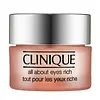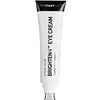What's inside
What's inside
 Key Ingredients
Key Ingredients

 Benefits
Benefits

 Concerns
Concerns

 Ingredients Side-by-side
Ingredients Side-by-side

Water
Skin ConditioningButyrospermum Parkii Butter
Skin ConditioningCetearyl Alcohol
EmollientButylene Glycol
HumectantHydrogenated Polyisobutene
EmollientPhenyl Trimethicone
Skin ConditioningPolyglyceryl-3 Beeswax
EmulsifyingPolybutene
Sucrose
HumectantCetyl Esters
EmollientPolymethyl Methacrylate
Isostearyl Neopentanoate
EmollientGlycerin
HumectantCetearyl Glucoside
EmulsifyingTocopheryl Acetate
AntioxidantTriticum Vulgare Germ Extract
Skin ConditioningHordeum Vulgare Extract
EmollientSigesbeckia Orientalis Extract
Skin ConditioningPEG-100 Stearate
Usnea Barbata Extract
Betula Alba Bud Extract
Skin ConditioningPolysilicone-11
Methyl Glucose Sesquistearate
EmollientCamellia Sinensis Leaf Extract
AntimicrobialSalvia Officinalis Leaf
MaskingGlyceryl Polymethacrylate
Yeast Extract
Skin ConditioningGentiana Lutea Root Extract
Skin ConditioningStearic Acid
CleansingMilk Protein
Skin ConditioningLactis Proteinum
Skin ConditioningPalmitoyl Oligopeptide
CleansingSqualane
EmollientMagnesium Ascorbyl Phosphate
AntioxidantCholesterol
EmollientCaffeine
Skin ConditioningPEG-8
HumectantPhytosphingosine
Skin ConditioningAcrylates/C10-30 Alkyl Acrylate Crosspolymer
Emulsion StabilisingAminomethyl Propanol
BufferingDimethicone
EmollientIsomerized Linoleic Acid
Skin ConditioningLinoleic Acid
CleansingSodium Hyaluronate
Humectant1,2-Hexanediol
Skin ConditioningDecarboxy Carnosine Hcl
Skin ConditioningPotassium Sulfate
Caprylyl Glycol
EmollientDisodium EDTA
Sodium Dehydroacetate
PreservativePhenoxyethanol
PreservativeCI 19140
Cosmetic ColorantMica
Cosmetic ColorantIron Oxides
CI 77891
Cosmetic ColorantWater, Butyrospermum Parkii Butter, Cetearyl Alcohol, Butylene Glycol, Hydrogenated Polyisobutene, Phenyl Trimethicone, Polyglyceryl-3 Beeswax, Polybutene, Sucrose, Cetyl Esters, Polymethyl Methacrylate, Isostearyl Neopentanoate, Glycerin, Cetearyl Glucoside, Tocopheryl Acetate, Triticum Vulgare Germ Extract, Hordeum Vulgare Extract, Sigesbeckia Orientalis Extract, PEG-100 Stearate, Usnea Barbata Extract, Betula Alba Bud Extract, Polysilicone-11, Methyl Glucose Sesquistearate, Camellia Sinensis Leaf Extract, Salvia Officinalis Leaf, Glyceryl Polymethacrylate, Yeast Extract, Gentiana Lutea Root Extract, Stearic Acid, Milk Protein, Lactis Proteinum, Palmitoyl Oligopeptide, Squalane, Magnesium Ascorbyl Phosphate, Cholesterol, Caffeine, PEG-8, Phytosphingosine, Acrylates/C10-30 Alkyl Acrylate Crosspolymer, Aminomethyl Propanol, Dimethicone, Isomerized Linoleic Acid, Linoleic Acid, Sodium Hyaluronate, 1,2-Hexanediol, Decarboxy Carnosine Hcl, Potassium Sulfate, Caprylyl Glycol, Disodium EDTA, Sodium Dehydroacetate, Phenoxyethanol, CI 19140, Mica, Iron Oxides, CI 77891
Water
Skin ConditioningDimethicone
EmollientCoco-Caprylate/Caprate
EmollientGlycerin
HumectantCaprylic/Capric Triglyceride
MaskingGlyceryl Stearate
EmollientCandelilla/Jojoba/Rice Bran Polyglyceryl-3 Esters
EmulsifyingPunica Granatum Seed Oil
EmollientEthylhexyl Palmitate
EmollientMica
Cosmetic ColorantPhenoxyethanol
PreservativeCetearyl Alcohol
EmollientSodium Stearoyl Lactylate
EmulsifyingBenzyl Alcohol
PerfumingPolysilicone-11
Hydroxyacetophenone
AntioxidantSodium Stearoyl Glutamate
CleansingTocopheryl Acetate
AntioxidantAcrylates/C10-30 Alkyl Acrylate Crosspolymer
Emulsion StabilisingSodium Gluconate
Skin ConditioningEthylhexylglycerin
Skin ConditioningSilica
AbrasiveDehydroacetic Acid
PreservativeDiglucosyl Gallic Acid
Sodium Hydroxide
BufferingTrihydroxystearin
Skin ConditioningTin Oxide
AbrasiveSodium Hyaluronate
HumectantGlucomannan
Skin ConditioningCI 77891
Cosmetic ColorantWater, Dimethicone, Coco-Caprylate/Caprate, Glycerin, Caprylic/Capric Triglyceride, Glyceryl Stearate, Candelilla/Jojoba/Rice Bran Polyglyceryl-3 Esters, Punica Granatum Seed Oil, Ethylhexyl Palmitate, Mica, Phenoxyethanol, Cetearyl Alcohol, Sodium Stearoyl Lactylate, Benzyl Alcohol, Polysilicone-11, Hydroxyacetophenone, Sodium Stearoyl Glutamate, Tocopheryl Acetate, Acrylates/C10-30 Alkyl Acrylate Crosspolymer, Sodium Gluconate, Ethylhexylglycerin, Silica, Dehydroacetic Acid, Diglucosyl Gallic Acid, Sodium Hydroxide, Trihydroxystearin, Tin Oxide, Sodium Hyaluronate, Glucomannan, CI 77891
 Reviews
Reviews

Ingredients Explained
These ingredients are found in both products.
Ingredients higher up in an ingredient list are typically present in a larger amount.
Acrylates/C10-30 Alkyl Acrylate Crosspolymer is a synthetic polymer. It is used to thicken and improve the texture of products. Due to its properties, it can prevent water and oil ingredients from separating.
Cetearyl alcohol is a mixture of two fatty alcohols: cetyl alcohol and stearyl alcohol. It is mainly used as an emulsifier. Emulsifiers help prevent the separation of oils and products. Due to its composition, it can also be used to thicken a product or help create foam.
Cetearyl alcohol is an emollient. Emollients help soothe and hydrate the skin by trapping moisture.
Studies show Cetearyl alcohol is non-toxic and non-irritating. The FDA allows products labeled "alcohol-free" to have fatty alcohols.
This ingredient is usually derived from plant oils such as palm, vegetable, or coconut oils. There is debate on whether this ingredient will cause acne.
Due to the fatty acid base, this ingredient may not be Malassezia folliculitis safe.
Learn more about Cetearyl AlcoholCi 77891 is a white pigment from Titanium dioxide. It is naturally found in minerals such as rutile and ilmenite.
It's main function is to add a white color to cosmetics. It can also be mixed with other colors to create different shades.
Ci 77891 is commonly found in sunscreens due to its ability to block UV rays.
Learn more about CI 77891Dimethicone is a type of synthetic silicone created from natural materials such as quartz.
What it does:
Dimethicone comes in different viscosities:
Depending on the viscosity, dimethicone has different properties.
Ingredients lists don't always show which type is used, so we recommend reaching out to the brand if you have questions about the viscosity.
This ingredient is unlikely to cause irritation because it does not get absorbed into skin. However, people with silicone allergies should be careful about using this ingredient.
Note: Dimethicone may contribute to pilling. This is because it is not oil or water soluble, so pilling may occur when layered with products. When mixed with heavy oils in a formula, the outcome is also quite greasy.
Learn more about DimethiconeGlycerin is already naturally found in your skin. It helps moisturize and protect your skin.
A study from 2016 found glycerin to be more effective as a humectant than AHAs and hyaluronic acid.
As a humectant, it helps the skin stay hydrated by pulling moisture to your skin. The low molecular weight of glycerin allows it to pull moisture into the deeper layers of your skin.
Hydrated skin improves your skin barrier; Your skin barrier helps protect against irritants and bacteria.
Glycerin has also been found to have antimicrobial and antiviral properties. Due to these properties, glycerin is often used in wound and burn treatments.
In cosmetics, glycerin is usually derived from plants such as soybean or palm. However, it can also be sourced from animals, such as tallow or animal fat.
This ingredient is organic, colorless, odorless, and non-toxic.
Glycerin is the name for this ingredient in American English. British English uses Glycerol/Glycerine.
Learn more about GlycerinMica is a naturally occurring mineral used to add shimmer and color in cosmetics. It can also help improve the texture of a product or give it an opaque, white/silver color.
Serecite is the name for very fine but ragged grains of mica.
This ingredient is often coated with metal oxides like titanium dioxide. Trace amounts of heavy metals may be found in mica, but these metals are not harmful in our personal products.
Mica has been used since prehistoric times throughout the world. Ancient Egyptian, Indian, Greek, Roman, Aztec, and Chinese civilizations have used mica.
Learn more about MicaPhenoxyethanol is a preservative that has germicide, antimicrobial, and aromatic properties. Studies show that phenoxyethanol can prevent microbial growth. By itself, it has a scent that is similar to that of a rose.
It's often used in formulations along with Caprylyl Glycol to preserve the shelf life of products.
Polysilicone-11 is a film-forming silicone that creates a non-tacky and matte finish on the skin. It's commonly used to improve texture, absorb excess oil, and help active ingredients spread evenly.
Due to its "rubber-like" structure, it stays on the skin's surface instead of being absorbed. On the skin, it creates a flexible layer that enhances wearability and stability.
Sodium Hyaluronate is hyaluronic acid's salt form. It is commonly derived from the sodium salt of hyaluronic acid.
Like hyaluronic acid, it is great at holding water and acts as a humectant. This makes it a great skin hydrating ingredient.
Sodium Hyaluronate is naturally occurring in our bodies and is mostly found in eye fluid and joints.
These are some other common types of Hyaluronic Acid:
Learn more about Sodium HyaluronateTocopheryl Acetate is AKA Vitamin E. It is an antioxidant and protects your skin from free radicals. Free radicals damage the skin by breaking down collagen.
One study found using Tocopheryl Acetate with Vitamin C decreased the number of sunburned cells.
Tocopheryl Acetate is commonly found in both skincare and dietary supplements.
Learn more about Tocopheryl AcetateWater. It's the most common cosmetic ingredient of all. You'll usually see it at the top of ingredient lists, meaning that it makes up the largest part of the product.
So why is it so popular? Water most often acts as a solvent - this means that it helps dissolve other ingredients into the formulation.
You'll also recognize water as that liquid we all need to stay alive. If you see this, drink a glass of water. Stay hydrated!
Learn more about Water